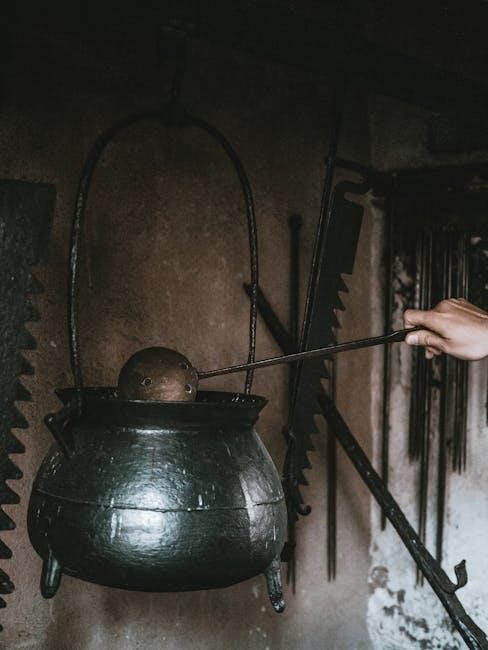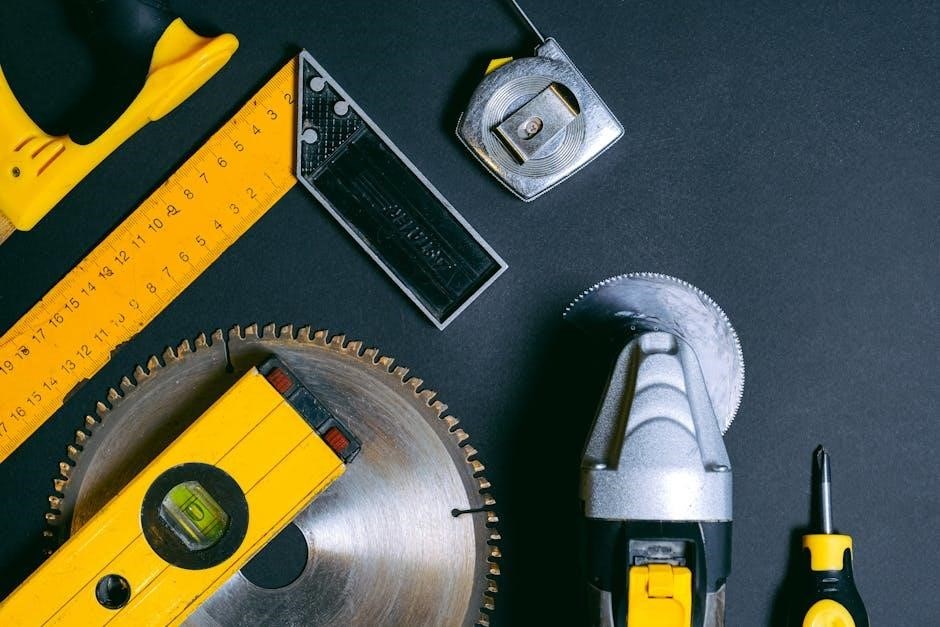
Dovetail saw guides enhance precision and consistency when cutting dovetail joints, aiding both pins and tails alignment. They simplify the process, ensuring accurate cuts with minimal effort.
What is a Dovetail Saw Guide?
A dovetail saw guide is a tool designed to assist woodworkers in making precise cuts for dovetail joints. It helps maintain accuracy and consistency when sawing, ensuring clean and straight edges. The guide typically features a sliding clamp that fits on either side, allowing for both pin and tail cuts. It accommodates various material thicknesses and is compatible with different saw types. Homemade versions can be crafted quickly, offering a customizable solution. This tool is essential for achieving professional-looking joints without extensive experience, making it a valuable asset for both beginners and skilled craftsmen.
Why Use a Dovetail Saw Guide?
A dovetail saw guide is indispensable for achieving precise, clean cuts in dovetail joints. It enhances accuracy and consistency, ensuring straight edges and perfectly aligned pins and tails. By minimizing human error, it saves time and reduces waste. Beginners benefit from its ease of use, while experienced woodworkers appreciate its efficiency. The guide accommodates various material thicknesses and works with different saw types, making it versatile for diverse projects. Its ability to simplify the cutting process without compromising quality makes it an essential tool for both hobbyists and professionals aiming for professional-looking results.
Brief History of Dovetail Saw Guides
Brief History of Dovetail Saw Guides
Dovetail saw guides have evolved alongside woodworking techniques, tracing their origins to 18th-century cabinetmaking. Initially simple tools, they were crafted from wood or metal to assist in precise dovetail cuts. The Industrial Revolution brought standardized designs, making them more accessible. Modern guides incorporate adjustable features and durable materials, enhancing functionality. Over time, they’ve become essential for both professional and amateur woodworkers, ensuring accurate joints with minimal effort. Their development reflects advancements in woodworking, emphasizing precision and efficiency in creating intricate joints.

Types of Dovetail Saw Guides
Dovetail saw guides come in adjustable and fixed designs, offering versatility for different projects. Metal guides provide durability, while wooden ones offer a traditional feel. Commercial guides are precision-engineered, whereas homemade versions allow customization, catering to various woodworking preferences and needs.
Adjustable vs. Fixed Guides
Adjustable dovetail saw guides offer flexibility, allowing users to customize the width and angle for various projects. They are ideal for intricate or varied woodworking tasks, providing precision and versatility. Fixed guides, however, are designed for specific joint sizes, ensuring consistency and simplicity. Adjustable guides are preferred by professionals for their adaptability, while fixed guides are great for beginners or repetitive tasks. Both types enhance accuracy but cater to different workshop needs and skill levels. Choosing between them depends on the project’s complexity and the user’s preference for versatility or ease of use.
Metal vs. Wooden Guides
Metal dovetail saw guides are known for their durability and precision, offering smooth adjustments and long-lasting performance. Wooden guides, while less common, provide a quieter, vibration-free experience. Metal guides are ideal for professionals needing consistent results, while wooden ones appeal to those who prefer a traditional feel. Both materials ensure accurate cuts, but metal guides are more robust and resistant to wear. Wooden guides, however, can be more affordable and easier to customize. The choice between metal and wood depends on personal preference, budget, and the level of precision required for the project.
Commercial vs. Homemade Guides
Commercial dovetail saw guides are precision-engineered for accuracy and durability, offering features like adjustable clamps and smooth operation. Homemade guides, while cost-effective, may lack the precision of commercial models. Homemade guides can be crafted quickly, such as making five pieces in 15 minutes, but require skill for accuracy. Commercial guides are ideal for professionals seeking consistent results, while homemade versions appeal to DIY enthusiasts or those on a budget. Both options can deliver quality cuts, but commercial guides often provide better reliability and ease of use, making them a worthwhile investment for frequent dovetailing tasks.

How to Choose the Right Dovetail Saw Guide
Selecting the right dovetail saw guide involves considering material type, adjustability, and ease of use. Choose between commercial or homemade options based on precision needs and budget.
Factors to Consider When Selecting a Guide
When selecting a dovetail saw guide, consider your skill level, budget, and project requirements. Adjustable guides offer flexibility for various joint sizes, while fixed guides provide simplicity for consistent cuts. Metal guides are durable and precise, whereas wooden ones may offer cost savings but require more maintenance. Homemade guides can be cost-effective but may lack the precision of commercial options. Consider the type of projects you undertake, as well as your need for portability or storage. Additionally, evaluate the ease of setup and alignment, as these factors impact efficiency and accuracy in your work. Choose a guide that balances durability, ease of use, and precision for your specific needs.
Top Features of a Good Dovetail Saw Guide
A good dovetail saw guide should offer precise alignment and stability, ensuring accurate cuts. Look for guides with adjustable settings to accommodate various dovetail sizes and angles. Durable materials, such as high-quality metal or sturdy wood, are essential for long-term reliability. Ease of setup and calibration is crucial for efficiency. Additionally, a guide that allows for smooth saw movement without binding is ideal. Portability and compact storage options are beneficial for workshop organization. Finally, compatibility with your saw and workpiece thickness ensures versatility and adaptability for different projects. These features collectively enhance precision, productivity, and overall user satisfaction.
Brands and Reviews
When selecting a dovetail saw guide, consider reputable brands known for precision and durability. Veritas and Incra are highly regarded for their adjustable and versatile designs, offering superior accuracy. Many woodworkers praise these brands for their ease of use and reliability. Online reviews often highlight guides with smooth operation, sturdy construction, and compatibility with various saws. Homemade guides are also popular among DIY enthusiasts, with tutorials available online. Reading reviews can help identify the best guide for your specific needs, whether you’re a professional or a hobbyist. High-quality brands and positive user feedback ensure a worthwhile investment for your woodworking projects.

Using a Dovetail Saw Guide
A dovetail saw guide ensures precise cuts by aligning your saw with the workpiece. It simplifies cutting both pins and tails, improving accuracy and reducing waste.
Setting Up Your Guide
Setting up your dovetail saw guide involves aligning it with your workpiece and securing it firmly. Ensure the guide is parallel to the edge of the wood for accurate cuts. Adjust the clamps or screws to hold the guide in place without applying too much pressure, which could warp the material. Double-check the alignment with a square or measuring tape to confirm proper positioning. This step is crucial for achieving consistent and precise dovetail joints, saving time and reducing the risk of errors during sawing.
Aligning the Guide with Your Workpiece
Aligning your dovetail saw guide with the workpiece is essential for accurate cuts. Start by positioning the guide along the marked dovetail layout, ensuring it is flush with the edges. Use a square or measuring tape to verify proper alignment. Secure the guide with clamps or screws, making sure it is tight enough to prevent movement but not so tight that it warps the material. Double-check the alignment from multiple angles to ensure consistency. Proper alignment ensures precise cuts, making the sawing process easier and the final joint stronger and more professional-looking.
Best Practices for Sawing Accuracy
For optimal accuracy when using a dovetail saw guide, ensure the workpiece is securely clamped to prevent movement. Use a consistent reference edge to guide the saw, maintaining steady, gentle pressure. Apply a marker or pencil to clearly mark the cut lines for better visibility. Keep the saw blade well-lubricated to reduce friction and prevent binding. Double-check the alignment of the guide before starting the cut. By following these practices, you can achieve precise, professional-looking dovetail joints with minimal effort and wasted material.

Techniques and Tips
Use consistent reference edges and maintain control for precise cuts. Keep the blade well-lubricated and aligned with the guide for optimal accuracy and smooth operation.
Basic Sawing Techniques
Mastering basic sawing techniques is essential for using a dovetail saw guide effectively. Start by ensuring proper alignment of the guide with your workpiece. Gently begin the cut, applying consistent, light pressure. Maintain control throughout the stroke, keeping the saw blade straight and steady. Use the guide to help track the blade, ensuring straight and precise cuts. Practice starting and completing cuts smoothly to avoid tear-out. Keep the blade well-lubricated to reduce friction and improve accuracy. Regular practice will enhance your skill and confidence in producing clean, accurate dovetail joints.
Advanced Techniques for Precision
For advanced precision, employ angled cuts and adjust the guide to accommodate varying joint sizes. Use specialized blades designed for dovetailing, ensuring minimal set and maximum control. Optimize guide settings for tight joints, reducing material removal. Practice cutting in both directions, maintaining consistent pressure to prevent binding. Utilize the guide’s adjustability to fine-tune alignments, achieving near-perfect joints. Incorporate subtle tilts for complex designs while keeping the blade straight. Regularly inspect and maintain the guide to ensure accuracy. These techniques enhance efficiency and precision, allowing for intricate dovetail work with ease and consistency.
Using a Guide for Both Pins and Tails
A dovetail saw guide excels at facilitating both pin and tail cuts with precision. For pins, the guide ensures straight, accurate cuts, while for tails, it helps maintain proper alignment. By adjusting the guide’s clamp to fit either side, you can seamlessly transition between tasks. This dual functionality saves time and reduces setup complexity, allowing for consistent joints. The guide’s adjustability ensures precise angles and depths for both pins and tails, making it an indispensable tool for achieving professional-grade dovetail joints efficiently.

Maintenance and Care
Regularly clean your dovetail saw guide to prevent debris buildup. Store it in a dry place to avoid rust. Check for damage or wear and lubricate moving parts for smooth operation.
Cleaning and Storing Your Guide
Cleaning your dovetail saw guide regularly is essential for maintaining accuracy. Use a soft cloth to wipe away dust and debris. Avoid harsh chemicals, as they may damage the finish. For storage, keep the guide in a dry, cool place away from direct sunlight. Consider placing it in a protective case or pouch to prevent scratches. Proper storage ensures the guide remains in good condition and ready for future use. Regular maintenance will extend the life of your tool and ensure consistent performance.
Adjusting and Calibrating the Guide
Adjusting and calibrating your dovetail saw guide ensures precise cuts and alignment. Start by cleaning the guide to remove any debris. Next, align the guide with your saw blade, ensuring it fits snugly. Use a ruler or gauge to verify accuracy. If your guide is adjustable, fine-tune it to match your project’s specific needs. Regular calibration prevents misalignment and improves cutting consistency. Store the guide properly after adjustment to maintain its settings. This process ensures your tool remains reliable, providing accurate results for all your dovetail projects.
Troubleshooting Common Issues
Common issues with dovetail saw guides often stem from misalignment or improper setup. If cuts are uneven, check the guide’s alignment with the saw blade. Ensure the guide fits snugly against the workpiece. For homemade guides, verify the build quality and adjust as needed. If the guide slips, secure it firmly or use clamps. Misalignment can also occur from uneven material surfaces. Sand surfaces flat before use. Regularly inspect the guide for wear and tear. Addressing these issues ensures consistent results and prolongs the guide’s effectiveness. Proper troubleshooting can save time and improve the accuracy of your dovetail joints.

Safety Precautions
Always wear protective eyewear and ensure the workpiece is firmly secured. Keep loose clothing tied back and avoid distractions while sawing. Maintain a clean, clutter-free workspace.
General Workshop Safety
Ensuring a safe working environment is the foundation of any successful project. Always wear protective eyewear to guard against debris and dust. Secure the workpiece firmly to prevent unexpected movement during cutting. Keep loose clothing and long hair tied back to avoid entanglement with tools. Avoid distractions while operating saws or guides. Maintain a clean and well-lit workspace to reduce tripping hazards and improve visibility. Proper ventilation is also crucial, especially when working with wood finishes or adhesives. By following these practices, you create a safer, more efficient workspace that minimizes risks and enhances productivity.
Safe Handling of the Saw and Guide
Proper handling of the saw and guide is essential for safety and accuracy. Always grip the saw firmly but not overly tightly, maintaining control throughout the cut. Ensure the guide is securely attached to the workpiece before starting. Keep your hands and fingers away from the blade’s path, using the guide as a barrier. Avoid overreaching or leaning awkwardly, as this can lead to loss of control. Regularly inspect the saw and guide for damage or wear, addressing issues promptly. Store both tools in a dry, secure location when not in use to prevent accidents and maintain their condition.
Avoiding Common Mistakes
When using a dovetail saw guide, common mistakes include misalignment, improper blade selection, and inadequate guide maintenance. To avoid these, ensure the guide is securely clamped and aligned with your workpiece before cutting. Always use the correct saw blade for the task, as the wrong blade can lead to inaccurate cuts. Regularly clean and calibrate the guide to maintain precision. Additionally, avoid rushing the cutting process, as this can result in uneven or skewed joints. By paying attention to these details, you can achieve consistent and professional-quality dovetail joints with minimal effort and frustration.

Common Mistakes
Common mistakes include misaligning the guide, using the wrong saw blade, and failing to maintain the guide. These errors can lead to inaccurate cuts and poor joints.
Misalignment of the Guide
Misalignment is a common issue when using dovetail saw guides. It often occurs due to improper setup or uneven workpiece surfaces, leading to inaccurate cuts and poorly fitting joints.
To avoid this, ensure the guide is securely clamped and aligned with the workpiece. Double-check the reference edges and use a square to confirm proper positioning before cutting. This ensures precise results and maintains the integrity of the dovetail joint.
Using the Wrong Saw Blade
Using the wrong saw blade with a dovetail saw guide can lead to poor results, including uneven cuts and difficulty in maintaining joint accuracy. The blade’s tooth configuration and angle are critical for precise dovetail cuts.
Choose a blade with the appropriate teeth per inch (TPI) and geometry for your project. A rip-tooth blade is ideal for cutting with the grain, while a crosscut blade is better for cutting across the grain. Ensure the blade is sharp and well-maintained to avoid binding or uneven tracking within the guide.
Not Maintaining the Guide
Neglecting to maintain your dovetail saw guide can lead to reduced accuracy and performance over time. Dust, debris, and rust can accumulate, causing misalignment and uneven cuts. Regular cleaning with a soft cloth and light oil helps prevent corrosion and ensures smooth operation. Proper storage in a dry, protected area is essential to avoid damage. Additionally, checking and tightening any loose parts prevents wobbling or play in the guide. Consistent upkeep ensures your guide remains reliable and continues to deliver precise results for your woodworking projects.

Dovetail Saw Guide Projects
Dovetail saw guides are essential for creating precise joints in woodworking projects, from simple boxes to complex cabinetry. They help achieve professional results with ease and accuracy.
Simple Projects for Beginners
Start with small, manageable projects like building a basic box or drawer. These tasks are perfect for mastering the use of a dovetail saw guide. Begin by creating small joints to practice precision and alignment. Simple projects allow you to gain confidence in handling the guide and saw effectively. Try making a wooden jewelry box or a small storage container. These exercises will help you understand the fundamentals of dovetail construction without overwhelming complexity. As you progress, you can gradually move on to more intricate designs, ensuring a solid foundation in using your dovetail saw guide.
Intermediate Projects
Once comfortable with the basics, move on to intermediate projects that challenge your skills. Consider crafting a small keepsake box or a recipe box with intricate dovetail joints. These projects require precision and attention to detail. You can also create a picture frame with a drawer or a small cabinet. Such tasks help refine your technique and build confidence. They also introduce you to working with different wood types and designs. Intermediate projects are ideal for honing your ability to use the dovetail saw guide effectively while exploring more complex joinery. This step is crucial before tackling advanced woodworking endeavors.
Advanced Projects
Advanced projects using a dovetail saw guide involve intricate designs and complex joinery. Consider creating a multi-drawer chest, a grandfather clock, or a fine furniture piece like a rocking chair. These projects demand precision and mastery of dovetail joints. You can also craft custom cabinetry with detailed accents or build a Murphy desk with hidden compartments. Advanced projects allow you to explore challenging techniques, such as angled dovetails or double-lapped joints. They showcase your skill and attention to detail, pushing the limits of what you can achieve with a dovetail saw guide. Such endeavors often become heirloom-quality pieces, reflecting your expertise and creativity.

Additional Resources
Explore books, online tutorials, and woodworking communities for in-depth knowledge on dovetail saw guides. These resources offer detailed guides, expert tips, and hands-on learning opportunities.
Books on Dovetail Saw Guides
Books on dovetail saw guides provide detailed insights into techniques, tools, and best practices. Titles like Online tutorials and videos are excellent resources for mastering dovetail saw guides. Platforms like YouTube and Instagram offer step-by-step guides, tool comparisons, and expert tips. Many woodworking channels demonstrate how to set up and use guides effectively. Videos often cover basic techniques, advanced methods, and troubleshooting common issues. Some creators share homemade guide designs, while others focus on tool maintenance and sharpening. These visual aids make learning easier, especially for beginners. They also provide insights into choosing the right tools and materials. Whether you’re a novice or an experienced woodworker, online tutorials are a valuable resource for improving your dovetailing skills. Woodworking communities and forums are invaluable for discussing dovetail saw guides. Platforms like Reddit, specialized woodworking forums, and Facebook groups offer spaces to share experiences and seek advice. Users can ask questions, troubleshoot issues, and learn from experienced craftsmen. These communities often feature detailed discussions on guide setup, maintenance, and best practices. Many forums also include galleries showcasing projects made using dovetail saw guides, providing inspiration and practical insights. Engaging with these communities can enhance your woodworking skills and keep you informed about the latest techniques and tools in the craft.Online Tutorials and Videos
Communities and Forums